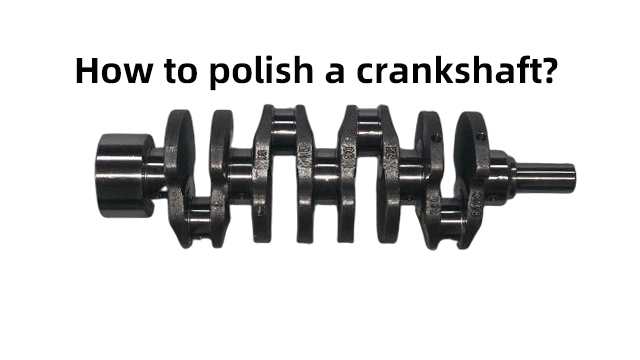How to Polish a Crankshaft?
2025-04-01 16:43:50 hits:0
How to Polish a Crankshaft: A Complete Guide for DIYers and Professionals
As a professional foundry, Tiegu boasts excellent machining capabilities and has rich experience and outstanding techniques in the field of crankshaft polishing. Today, let's explore in detail the relevant knowledge about crankshaft polishing.

What Does Polishing a Crankshaft Do?
Polishing a crankshaft is a crucial process that transforms the surface of the crankshaft from a rough and abrasive state to a smooth and precise one. By reducing microscopic imperfections, it achieves two key goals:
Friction Reduction: A polished surface minimizes the contact between the crankshaft and bearings, thus improving the efficiency and service life of the engine.
Oil Film Stability: A smooth finish helps maintain a stable oil film, preventing metal - to - metal contact under high loads.
Why Do the Crankshaft and Camshaft Need Polishing?
Both components operate under extreme stress. The lobes of the camshaft push the valves open at high speeds, while the crankshaft converts reciprocating motion into rotational motion. Without proper polishing:
Accelerated Wear: Rough surfaces cause premature wear of the bearings, leading to costly engine damage.
Performance Impact: Friction reduces horsepower and fuel efficiency.
Is Polishing a Crankshaft Necessary?
Absolutely - if you want to achieve optimal performance. Even new crankshafts may have machining marks from the factory. For high - performance engines (such as racing engines and diesel engines), polishing is essential to meet the strict surface finish requirements (Ra ≤ 10 micro - inches). For vintage or low - power engines, although polishing is still recommended, it is less critical.
Crankshaft Polishing Tools
The tools you use depend on your goals:
Professional Equipment-What machine is used to polish a crankshaft?
Grinding Machines: CNC - controlled grinding machines can machine the crankshaft to precise dimensions.
Polishing Lathes: Machines like the "Walterscheid" or "Junker" can rotate the crankshaft while applying abrasive belts for polishing.
Surface Roughness Testers: Devices like the "Mitutoyo SJ - 210" can measure the Ra value to ensure compliance with relevant standards (for example, Ra ≤ 15 micro - inches for standard engines).
DIY Tools
Sandpaper: Start with 200 - grit sandpaper for rough areas, and then use 400 - 800 - grit sandpaper for finishing.
Shoelace Polisher: A creative alternative to a lathe - wrap a shoelace around the crankshaft and pull it back and forth.
Kerosene: Soaking sandpaper in kerosene can enhance its cutting effect.
How to Polish a Crankshaft: Step - by - Step Guide
Step 1: Clean and Inspect
Degrease: Use a solvent to remove oil and debris.
Check for Damage: Use a magnifying glass or dye penetrant to check for cracks or severe wear.
Step 2: Grind First (If Necessary)
Directional Grinding: Grind in the direction opposite to the engine's rotation to create initial grooves.
Material Removal: Aim to remove no more than 0.0002 inches of material to avoid weakening the crankshaft.
Step 3: Polishing Process
Hand Polishing (DIY Method):
Wrap 200 - grit sandpaper around the journal of the crankshaft.
Pull the sandpaper back and forth in the same direction as the engine's rotation for 10 - 15 minutes.
Upgrade to 400 - 800 - grit sandpaper for a smoother finish.
Shoelace Technique:
Soak a shoelace in kerosene and thread it under the journal.
Pull both ends alternately to create a reciprocating motion.
Step 4: Professional Polishing (Optional)
Use a polishing lathe with progressively finer abrasive belts (for example, from 120 - grit to 600 - grit).
Maintain the correct rotation direction to ensure a uniform texture.
Step 5: Measure and Verify
Ra Value Check: Use a roughness tester to confirm that the Ra value meets the standard (Ra ≤ 15 micro - inches for standard engines and Ra ≤ 10 micro - inches for high - performance engines).
Visual Inspection: The surface should reflect light uniformly without visible scratches.
Expert Tips for Success
Safety First: Wear gloves and goggles to avoid abrasions.
Material Considerations:
Cast Iron: Extra care is required to prevent exposing the edges of graphite nodules.
Alloy Steel: More durable but harder to polish.
Avoid Over - Polishing: Excessive material removal weakens the crankshaft.
When to Seek Professional Help
If you lack specialized tools or experience.
For high - performance engines (such as diesel engines and racing engines).
If the crankshaft has deep scratches or cracks.
Final Thoughts
Polishing a crankshaft is a blend of art and engineering precision. While DIY methods suffice for basic maintenance, professional-grade results demand expertise and advanced machinery. At Tiegu Foundry, we combine decades of casting experience with state-of-the-art CNC machining to deliver crankshaft polishing services that meet SAE J438 standards and exceed customer expectations.
Why Choose Tiegu?
✅ ISO 9001-Certified Quality: Stringent quality control ensures consistent surface finishes (Ra ≤ 10μin for high-performance applications).
✅ Material Expertise: Specialized processes for cast iron, alloy steel, and ductile iron components.
✅ Turnkey Solutions: From rough casting to final polishing, we handle every stage in-house.
Let Us Handle Your Crankshaft Needs
Whether you’re restoring a vintage engine or building a high-performance racing machine, trust Tiegu Foundry to provide polished crankshafts that enhance durability and power. Request a free quote today and experience the difference of factory-direct precision.
📞 Contact Us: karvin@tiegu.com | 📍 Visit Our Factory 📍 Obtain casting quotation

 en
en  fra
fra  de
de  ru
ru  gle
gle  th
th  ara
ara  it
it  jp
jp  kor
kor  zh
zh 


